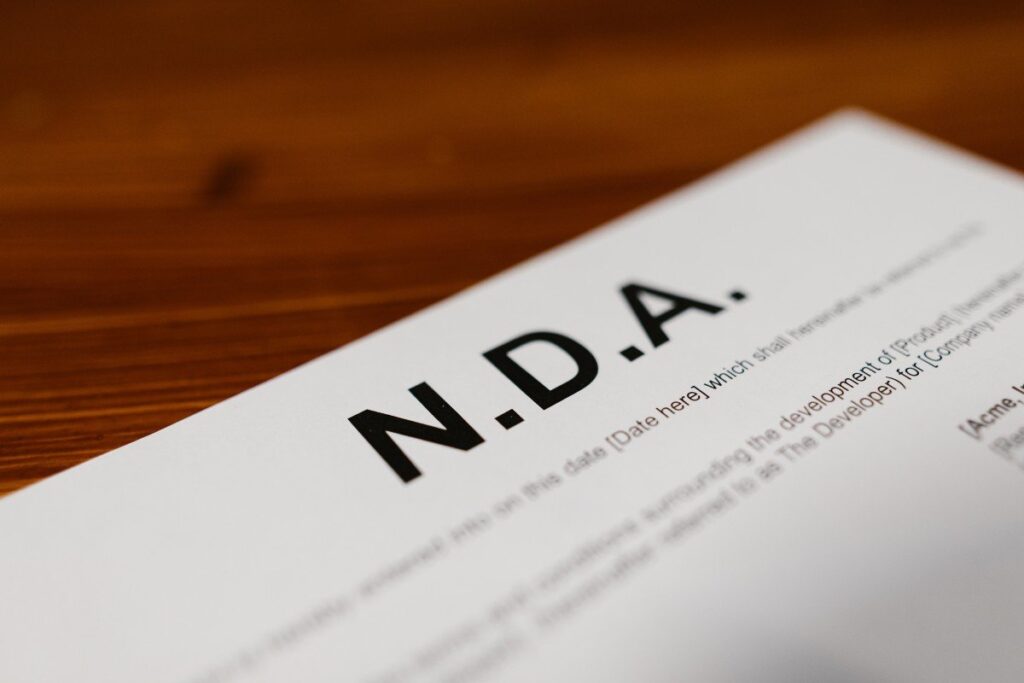“What did one NDA say to the other? ‘I’d let you know, but it is confidential.'”
A NDA is a very strong document, and there are many popular culture references where it’s presented as something that instills fear. However, it is a very important document; it shields you from many intrinsic and extraneous risks. The need for protection of intellectual property and private data in this dynamic and hostile business environment cannot be underestimated. Trade secrets, proprietary information, and creative ideas should always be protected regardless of whether the company is a startup, smaller company, or established one. An effective means of safeguarding confidential data is through the Non-Disclosure Agreement commonly referred to as NDA.
Understanding NDAs: A Shield for Your Secrets
A non-disclosure agreement (NDA) transforms an otherwise garrulous parrot into the greatest secret keeper in the world. It’s the magical spell that ensures your exclusive information doesn’t escape, even when tempted with a mountain of crackers.
On a serious note, Non-Disclosure Agreements (NDAs) are legally binding contracts that create a confidential relationship between the disclosing party and the receiving party. An NDA is mainly intended for protection of critical information, with confidentiality being a key aspect. NDAs protect your intellectual properties, proprietary information, and trade secrets from being leaked or exposed without authorization.
The Significance of NDAs
Why are NDAs so important? There are several reasons, some of which are listed below.
Safeguarding Intellectual Property: Intellectual property includes a wide range of creations, from innovations and trade secrets to creative works such as written content, software, and creative designs. NDAs are instrumental in maintaining the confidentiality of these assets.
Fostering Trust: When sharing sensitive information with employees, partners, contractors, or potential investors, an NDA helps establish trust. It signals to the receiving party that you take the protection of your exclusive information seriously.
Legal Recourse: An NDA provides a legal recourse for seeking compensation in case of a breach of contract. If the receiving party violates the terms of the agreement by disclosing your confidential information without your authorization, you have legal recourse to seek damages.
When to Use an NDA
An NDA need not be used willy-nilly. It is required in specific situations. They are enumerated thereafter.
Business Partnerships: NDAs must be in place when entering into partnerships, collaborations, and joint ventures. It means they make sure that confidential information is mutual and that both parties are bound to safeguard the information.
Employee and Contractor Relationships: Your employees and contractors frequently get exposed to proprietary information when you employ them. It is essential to have them sign an NDA so as not to share that information with competitors or use it for their personal gains.
Pitching to Investors: While in the process of seeking investors’ money for your business, you need to give details of your financial information as well as your plans on the business strategy. By doing this, NDAs guarantee a client that his sensitive information will not be abused.
Product Development: You should not forget to include NDA in case you are working with third-party developers or partners for a new product. These developers may seek to copy or share your innovative ideas and designs, which would be in violation of the legal agreement.
Drafting an Effective NDA
It is important to draft a sound and efficient confidentiality agreement to safeguard the confidential information. Some of the key elements to include are:
Definition of Confidential Information: Specify what is regarded as confidential. This may include trade secrets such as financial details, client lists and even the marketing strategy.
Obligations of the Receiving Party: List down the duties of the receiving party which includes avoiding revealing, using or copying the confidential data for any purpose other than the agreed one.
Duration of Confidentiality: Specify the period within which the receiving party is required to preserve the confidentiality of the information. This will depend on the quality of the information.
Consequences of Breach: In case of violation, specify the consequences of violation which may include legal action, injunctions and financial damages.
Jurisdiction and Governing Law: Specify the court having jurisdiction and controlling law applicable to the contract for resolution of disputes.

Enforcing an NDA
Do you agree that by itself a piece of paper is quite useless? To enforce it actually, it must pass through proper legal procedures.. Always seek advice from an attorney if you suspect a breach. They may seek an injunction, which can be used to prevent any further divulgence of the confidential information, file suit for damages caused by the breach or both.
In conclusion, Non-Disclosure Agreements (NDAs) play an important role in safeguarding your intellectual property and confidential information. They facilitate trust, provide legal redress and also protect your vital data. It is a strategic step for any organization operating within today’s tough business world knowing when and where to utilize an NDA. Ensure you are precise when writing a non-disclosure agreement in defining “confidential,” specifying the responsibilities of the other party and what can be done to the opposite party in case of the breach. With a solid NDA, you will have the confidence to take care of your business’s most vital assets in a highly interconnected business environment.




